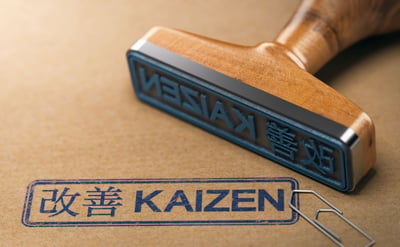 When asked to describe his threshold test for obscenity in 1964, United States Supreme Court Justice Potter Stewart famously said, "… perhaps I could never succeed in intelligibly doing so. But I know it when I see it."
When asked to describe his threshold test for obscenity in 1964, United States Supreme Court Justice Potter Stewart famously said, "… perhaps I could never succeed in intelligibly doing so. But I know it when I see it."
I feel a bit that way about defining the improvement concept known as kaizen. There are many ways to describe it, and I will share some of them in this post, but because kaizen is a way of thinking, of being, really, it is easier to recognize than to delineate. I do not doubt that there are countless organizations and people that practice the principles of kaizen without having ever heard the word.
Hopefully, once you've read this post, you'll know more about what kaizen looks like and how you can apply the philosophy to your daily approach to work.
The Short Version
While kaizen might be challenging to define, it's easy to translate. "Kaizen" is a Japanese word that can be translated to mean "improvement" or "change for the better." The two characters that make up the word are "Kai" (meaning "change") and "zen" (meaning "good").
As a business improvement term, kaizen originated at Toyota. It was understood that it was part of everyone's job to identify and implement incremental improvements in the workplace. Masaaki Imai documented the concept in his 1986 book KAIZEN. The idea caught fire and was adopted by Japanese companies en mass and later organizations in the United States and other countries.
Today, kaizen is the goal of many organizations worldwide. It is popular because it engages everyone in identifying and resolving problems and improving the flow of work.
Practical Application of Kaizen
I don't think anyone reading this post would say they don't want positive change in their organization. In that way, kaizen is a no-brainer. But integrating it into the daily activities of every person is no small task.
We've been fortunate to observe many organizations that have fully embraced the kaizen way. Here's what that looks like.
There are no fixed ideas about how things must be done. Moving close to perfection means acknowledging that today's methods aren't sacrosanct. The best ideas for positive change may require an entirely new way of looking at a process or problem.
Positive change isn't about blame. While improvement does require looking for the root cause of problems, the idea isn't to blame people. The goal is to identify process flaws and fix them. Respect for people is a critical element of kaizen.
While the goal is perfection, incremental improvements are embraced. They say that the perfect is the enemy of the good, and that's true if you reject any improvement that doesn't represent an ideal state. When practicing kaizen, a 20% improvement is always better than no improvement at all.
Errors are acknowledged, never ignored. Ignoring small problems until they become big ones, or applying workarounds to hide process failures are anti-kaizen. Kaizen practitioners address issues as soon as they are spotted, always looking for root causes.
Money is no substitute for creativity. One reason that positive change should be everyone's job is that it is quite possible your team members can suggest no or low-cost solutions to problems. The budget does not need to be a barrier to good change.
Experts are respected, but other perspectives also add value. In some cases, such as in a high-reliability organization, it is necessary to defer to expertise. However, with most business processes, other viewpoints can also be valuable in problem-solving. This particularly applies to the people who operate the process. For example, Toyota's factory workers weren't all engineers, but their ideas still led to performance improvements.
Decisions are made based on data, not opinions. Ideas for change should be creative and varied, but standard operating procedures should be crafted and adjusted based on measurable, objective data. Control charts are one tool used within kaizen to visualize process performance over time and drive decisions about change.
Improvement happens where work is done, not in a conference room. The kaizen approach is a bottom-up way of thinking about good change. The people who are closest to the products, customers, and processes are in the best position to recognize and implement opportunities for improvements. Leaders engaged in improvment, go to the place where work is done to observe and show respect.
There are a ton of tools and techniques used by organizations dedicated to kaizen; they are effective ways to support the practice. But at its core, kaizen is a way of looking at the world with an eye to making small changes in pursuit of perfection. Hopefully, now you will know it when you see it and work towards it when you don't.


Add a Comment